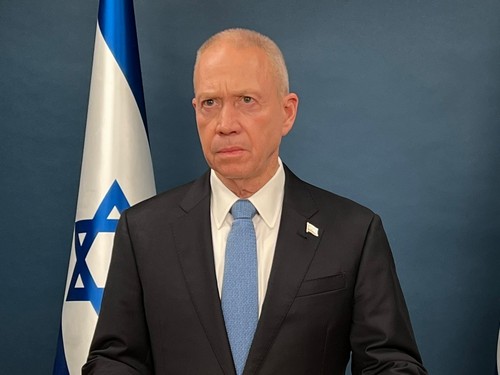Rafah (Gaza Strip): Israel’s defence minister Thursday laid out his vision for the next phase of the war in Gaza, describing how Israeli forces would shift to an apparently scaled-down “new combat approach” in northern Gaza, while continuing to fight Hamas in the south of the territory “for as long as necessary”.
Ahead of a visit by the US secretary of state, Yoav Gallant also outlined a proposal for how Gaza would be run once Hamas is defeated, with Israel keeping security control while an undefined, Israeli-guided Palestinian body runs day-to-day administration, and the US and other countries oversee rebuilding.
Israel has come under heavy international pressure to spell out a post-war vision but so far has not done so. The issue is likely to be on the agenda in Secretary of State Antony Blinken’s talks this weekend in Israel and other countries in the region. The United States has pressed Israel to shift to lower-intensity military operations in Gaza that more precisely target Hamas, after nearly three devastating months of bombardment and ground assaults.
The vagueness of many of Gallant’s provisions made it difficult to assess how much they mesh with the US calls.
The document issued by Gallant was titled a “vision for Phase 3” of the war, and Gallant’s office said the phase had not yet begun. It also said the ideas were Gallant’s and not official policy, which would have to be set by Israel’s war and security cabinets.
Gallant, who is a member of both cabinets, may be aiming to put his personal plan before the Americans ahead of others in Prime Minister Benjamin Netanyahu’s coalition, which includes hard-right members likely to want a tougher approach.
Israel’s campaign in Gaza has killed more than 22,400 people, more than two-thirds of them women and children, according to the Health Ministry in the Hamas-run territory. The ministry’s count does not differentiate between civilians and combatants. Israel has vowed to destroy Hamas after its October 7 attack, in which militants killed some 1,200 people and abducted around 240 others.
Much of northern Gaza, which troops invaded two months ago, has been flattened beyond recognition. Associated Press footage from Gaza City showed people wandering through a shattered landscape with large fields of broken concrete and splintered wood and streets lined with toppled buildings.
With the focus now in the south, Israeli forces are battling Hamas militants in the city of Khan Younis and in urban refugee camps in the centre of the territory.
Some 85 per cent of Gaza’s 2.3 million (23 lakh) people have been driven from their homes and squeezed into smaller slivers of the territory. Israel’s siege of the territory has caused a humanitarian crisis, with a quarter of the population starving because not enough supplies are entering, according to the UN.
At the same time, airstrikes and shelling across Gaza continue to destroy houses, burying families taking shelter inside.
An Israeli strike Thursday flattened a home in Mawasi, a small rural strip on Gaza’s southern coastline that Israel’s military had declared a safe zone. The blast killed at least 12 people, Palestinian hospital officials said. The dead included a man and his wife, seven of their children and three other children ranging in age from five to 14, according to a list of the dead who arrived at Nasser Hospital in nearby Khan Younis.
There was no immediate response from Israel’s military.
GALLANT’S VISION
Gallant’s statement underlined that the war would go on until Hamas’ military and government capabilities are eliminated and the more than 100 hostages still in captivity are returned.
In the north, the statement said, forces will shift to a new approach that includes raids, destruction of tunnels, “air and ground activities and special operations”. The aim would be “the erosion” of the remaining Hamas presence.
There was no word whether northern Gaza’s population, which has almost entirely been driven south, would be allowed to return.
The statement did not clarify how the new approach would differ from current operations, but Gallant has previously said it would be a lower scale. Israel began last week to withdraw some troops from northern Gaza, where the military says it has largely gained operational control after weeks of heavy fighting with Hamas. Still, Gallant has said several thousand Hamas fighters remain there.
In the south, he said, fighting would continue “as long as is deemed necessary”.
After the war, the statement said, Israel will keep security control, taking military action in Gaza when necessary to ensure there are no threats and maintaining inspections of all goods entering the territory.
Gallant said there would be no Israeli civilians in Gaza, ruling out calls by some in Israel’s far-right for a return of Jewish settlers to the territory.
Israel withdrew its troops and settlers from Gaza in 2005 after a 38-year presence.
Palestinian entities — apparently local civil servants or communal leaders — would run the territory, with Israel providing “information to guide civilian operations”, the statement said without elaborating. A multinational task force, led by the US, would be in charge of rebuilding.
AP
